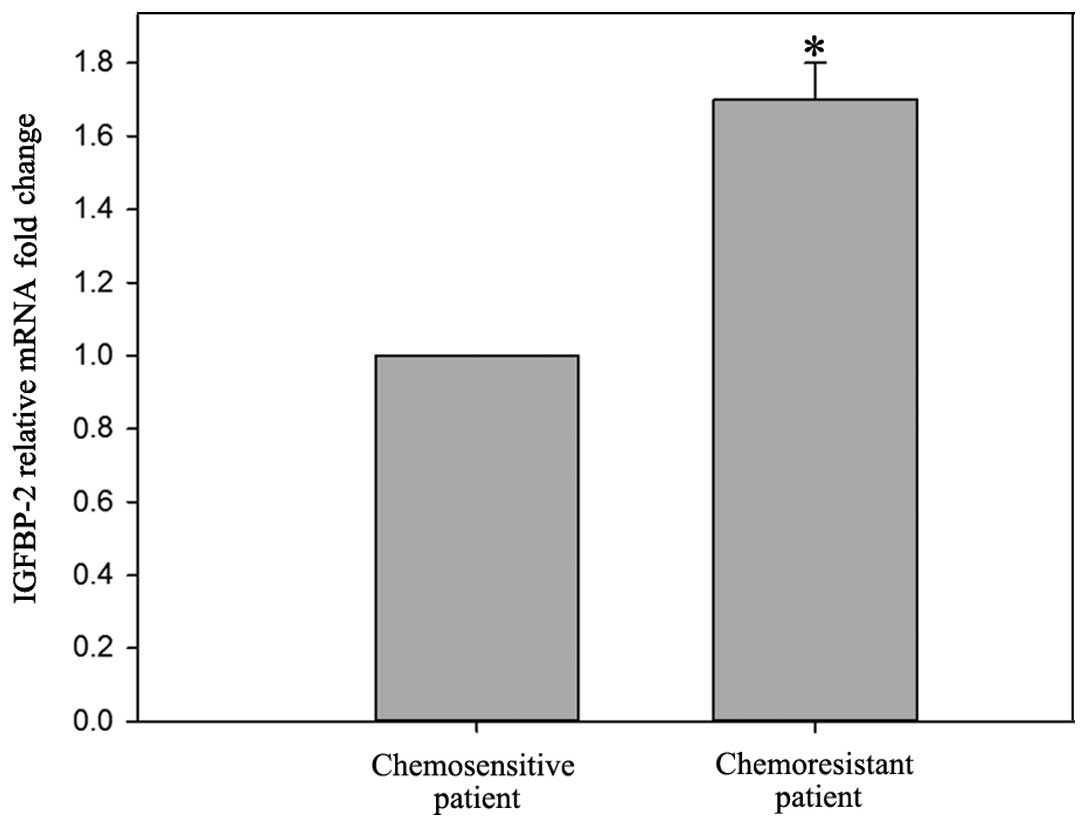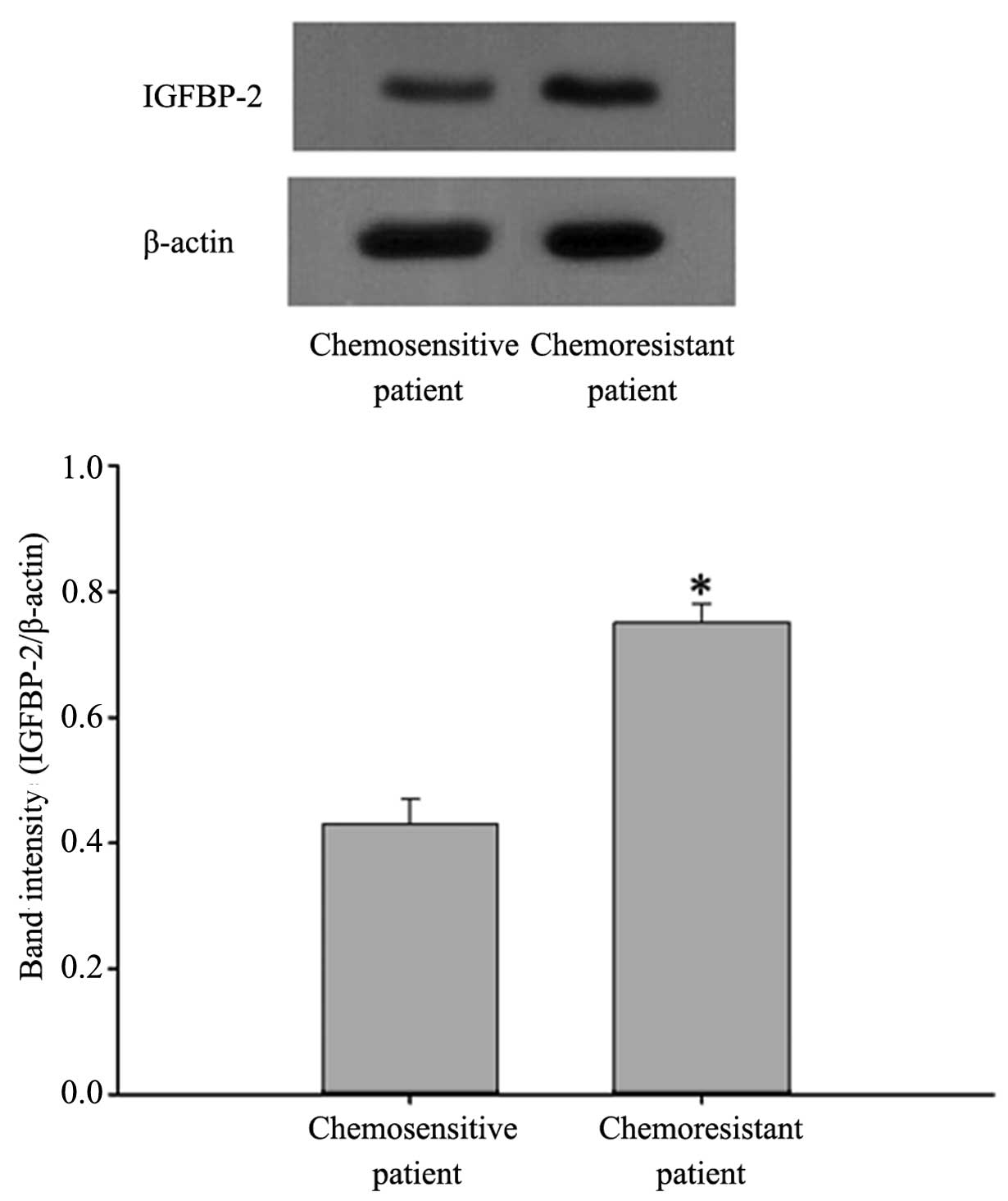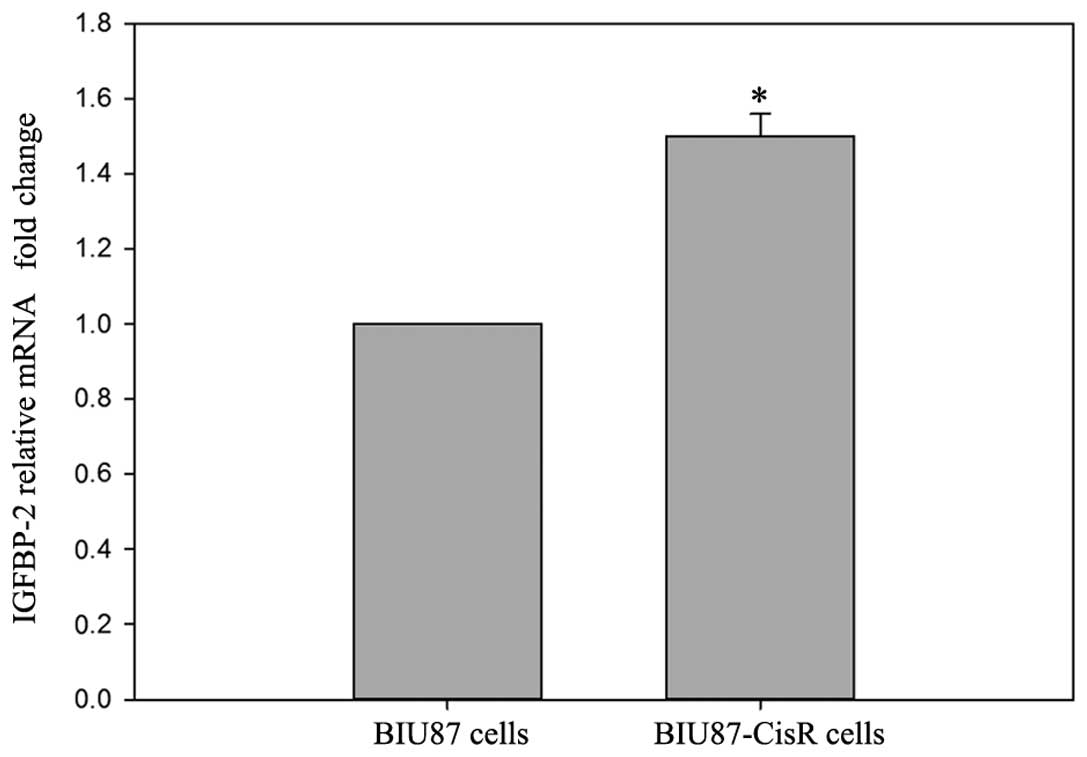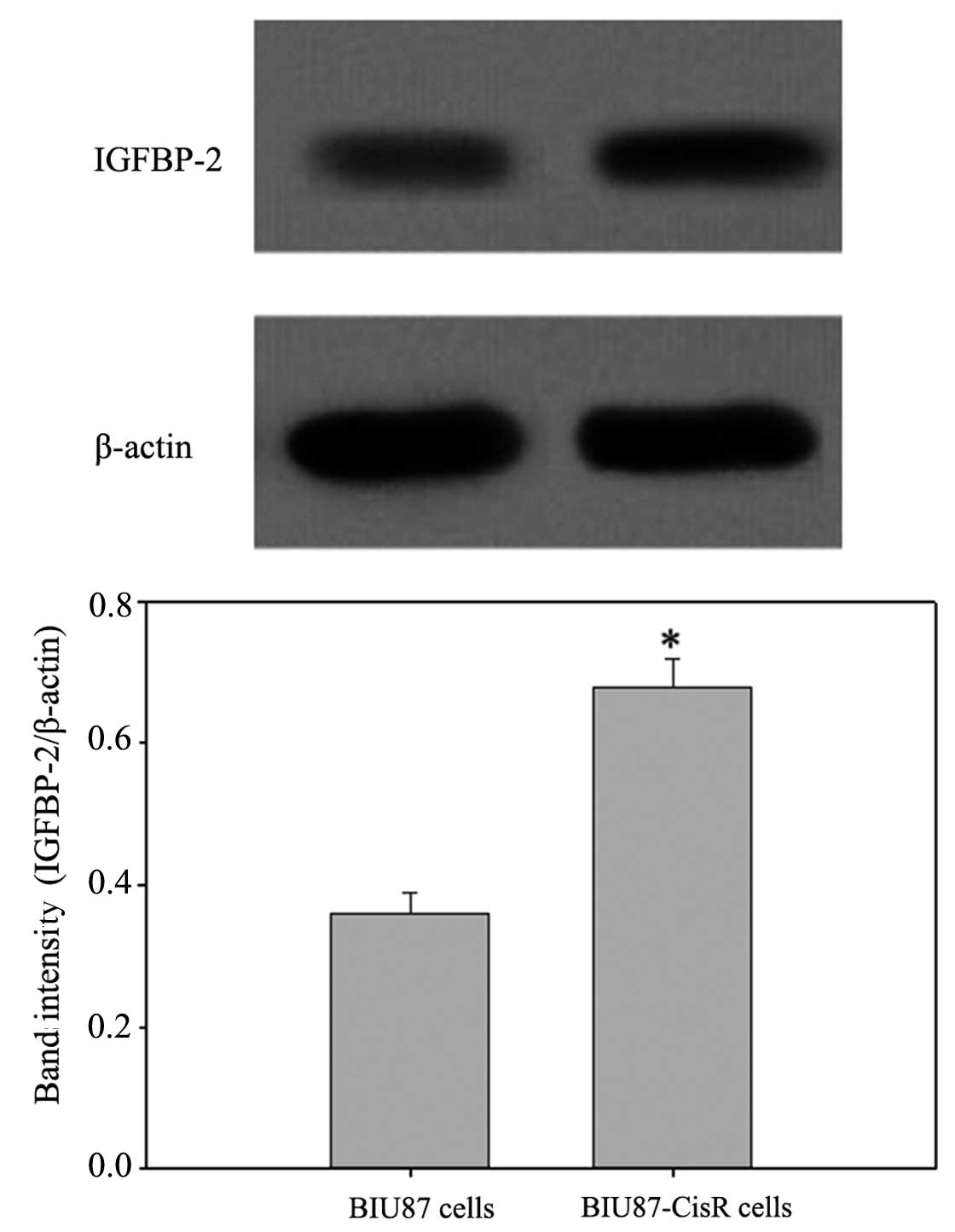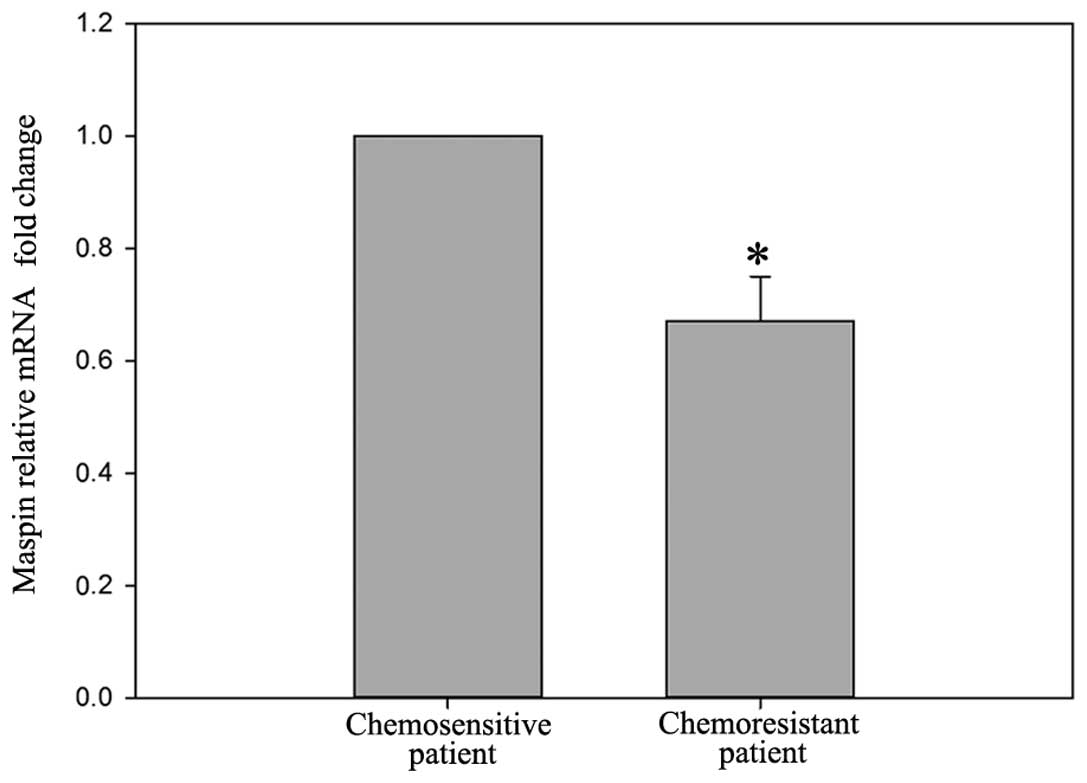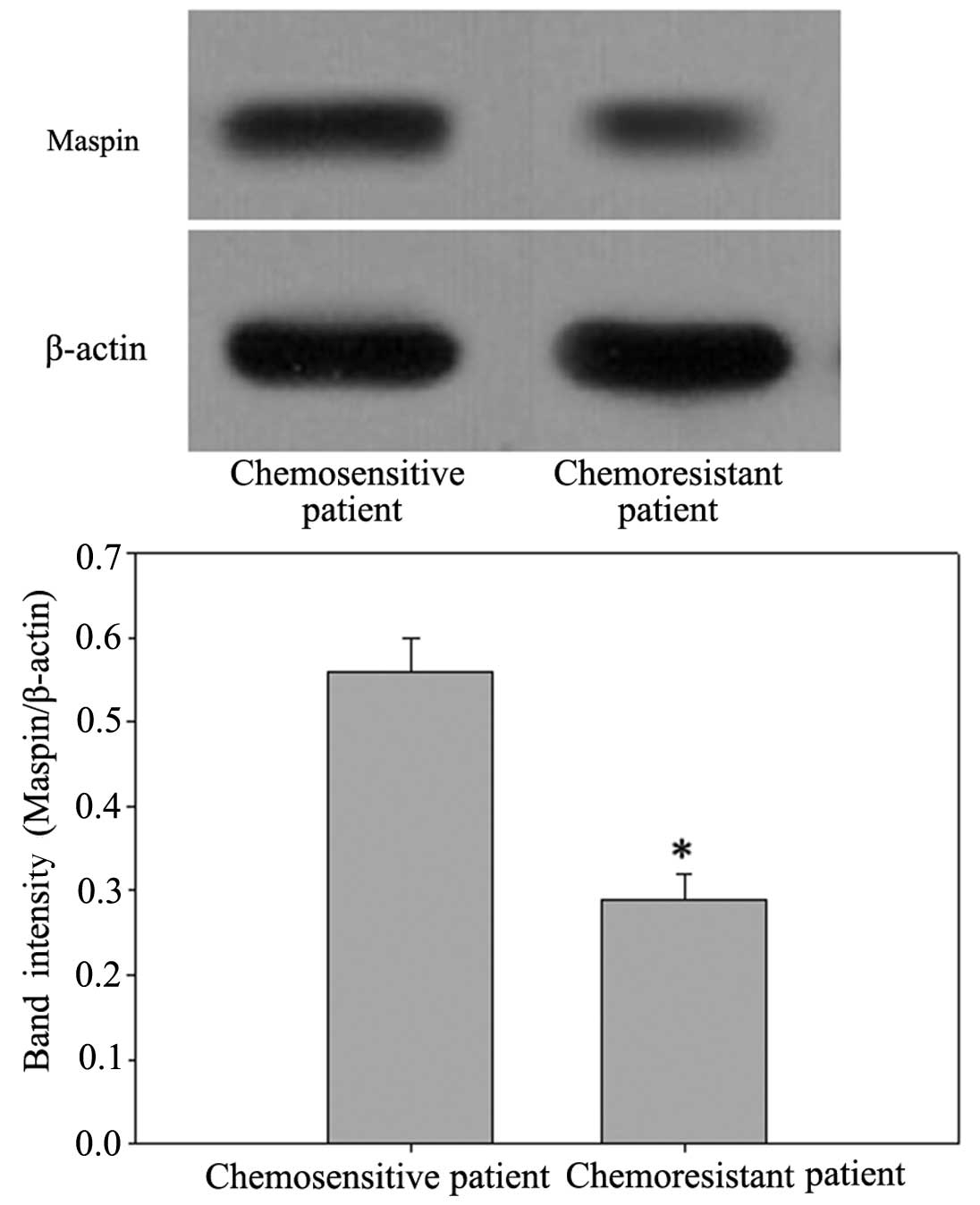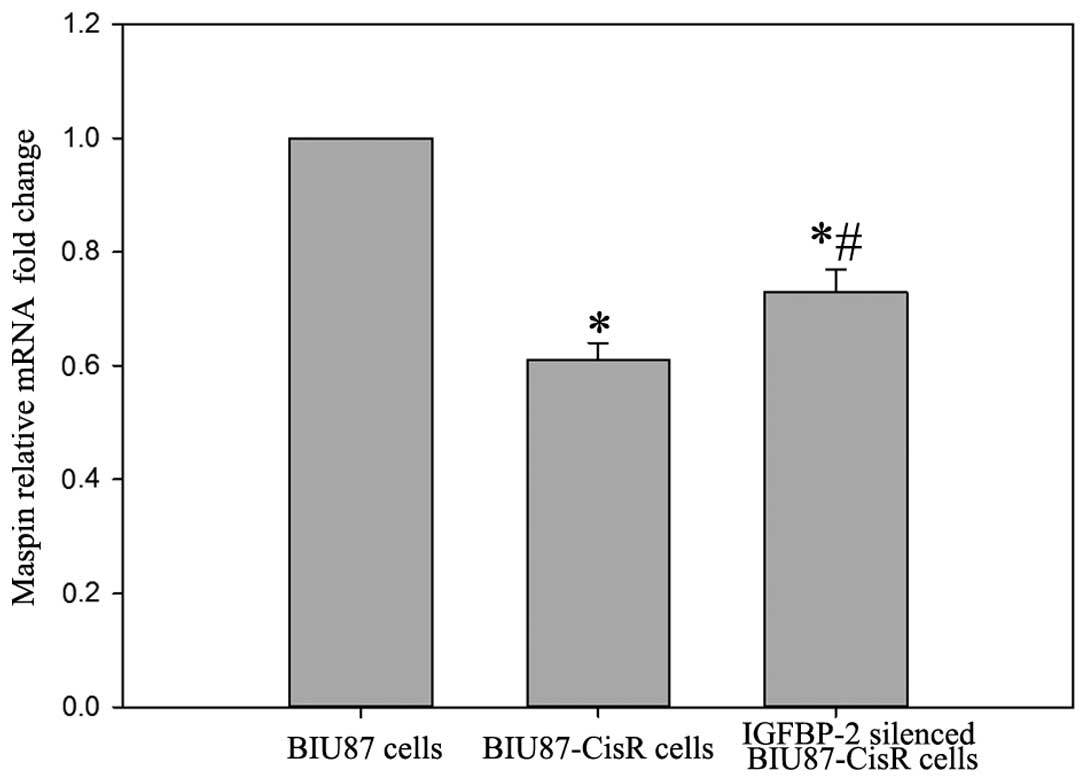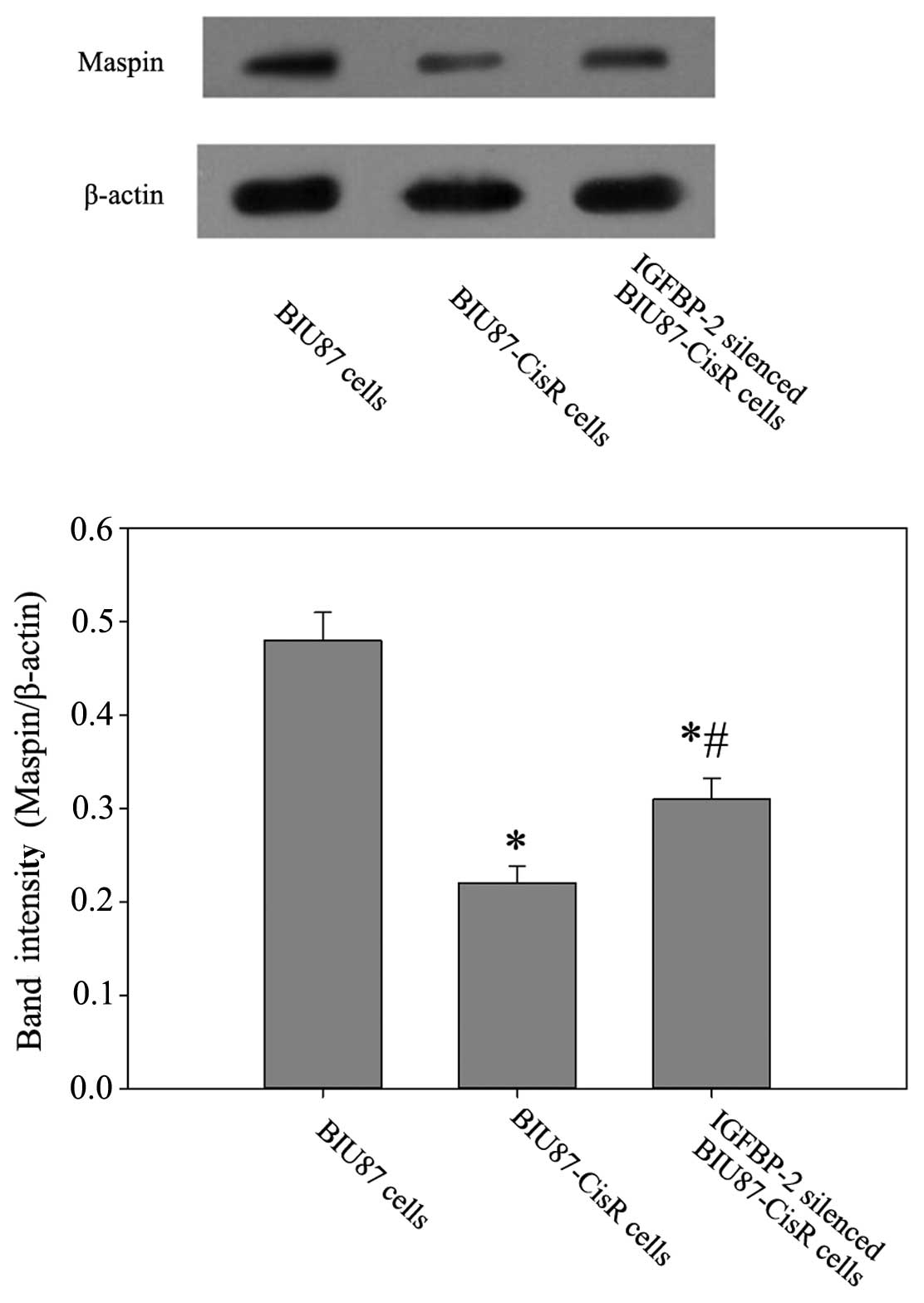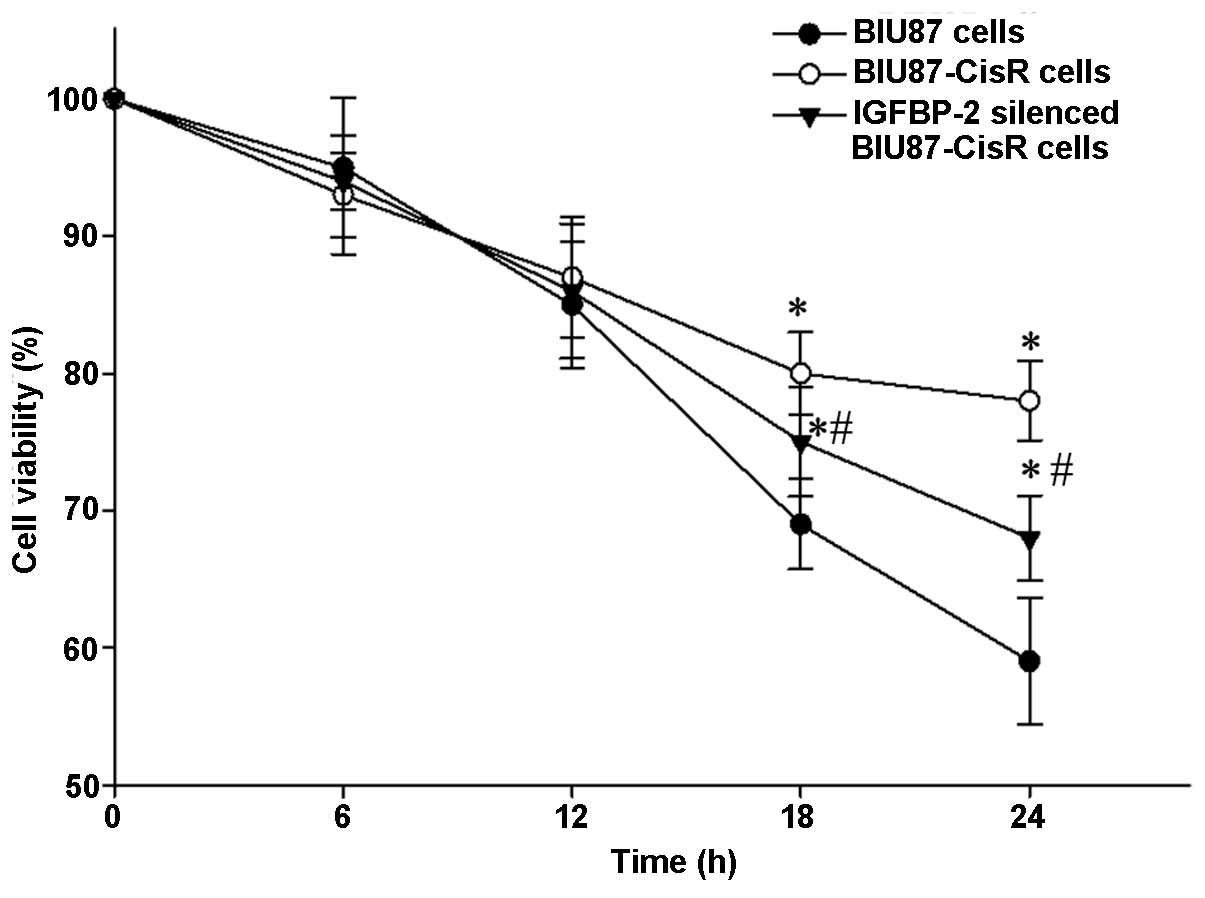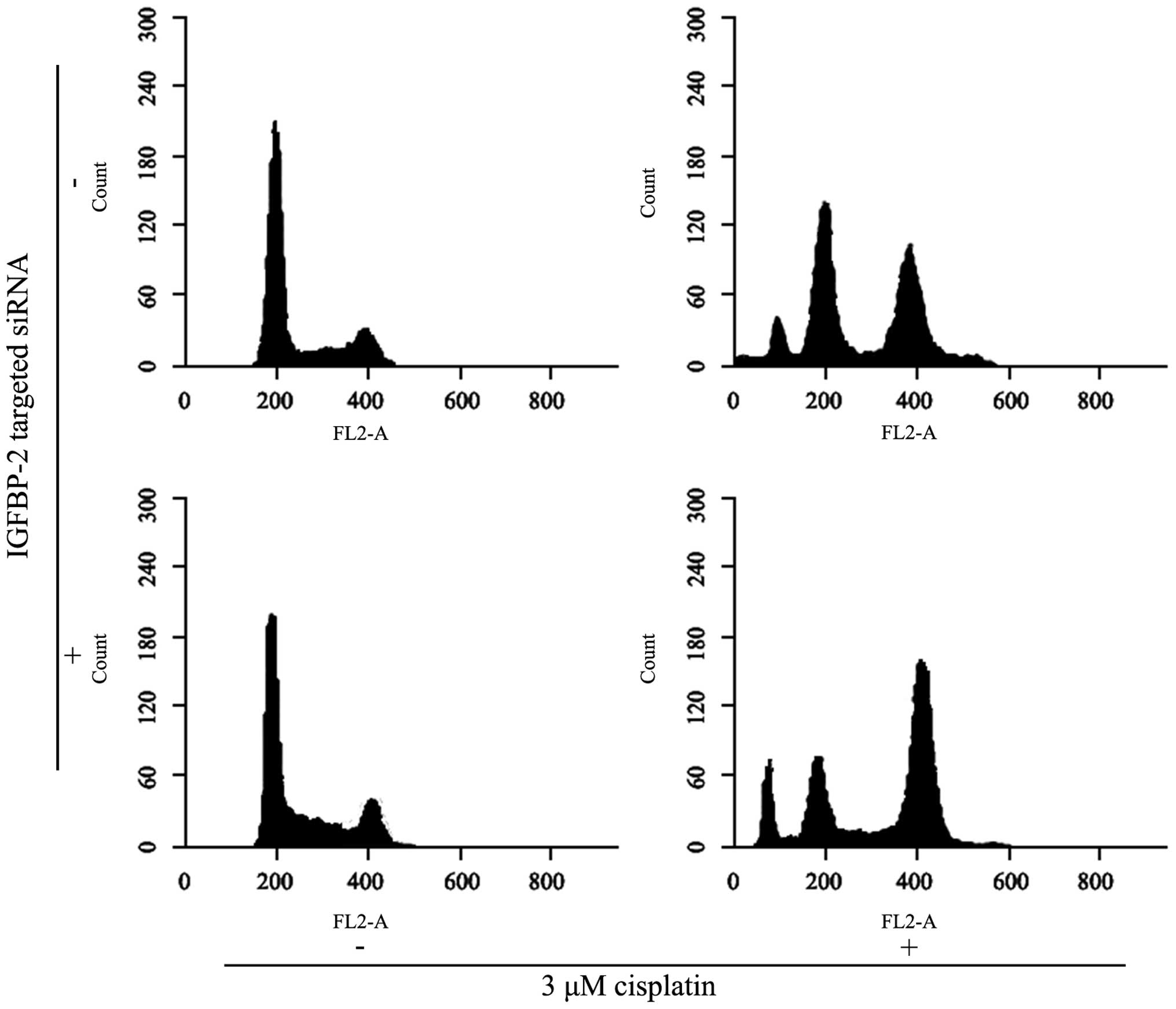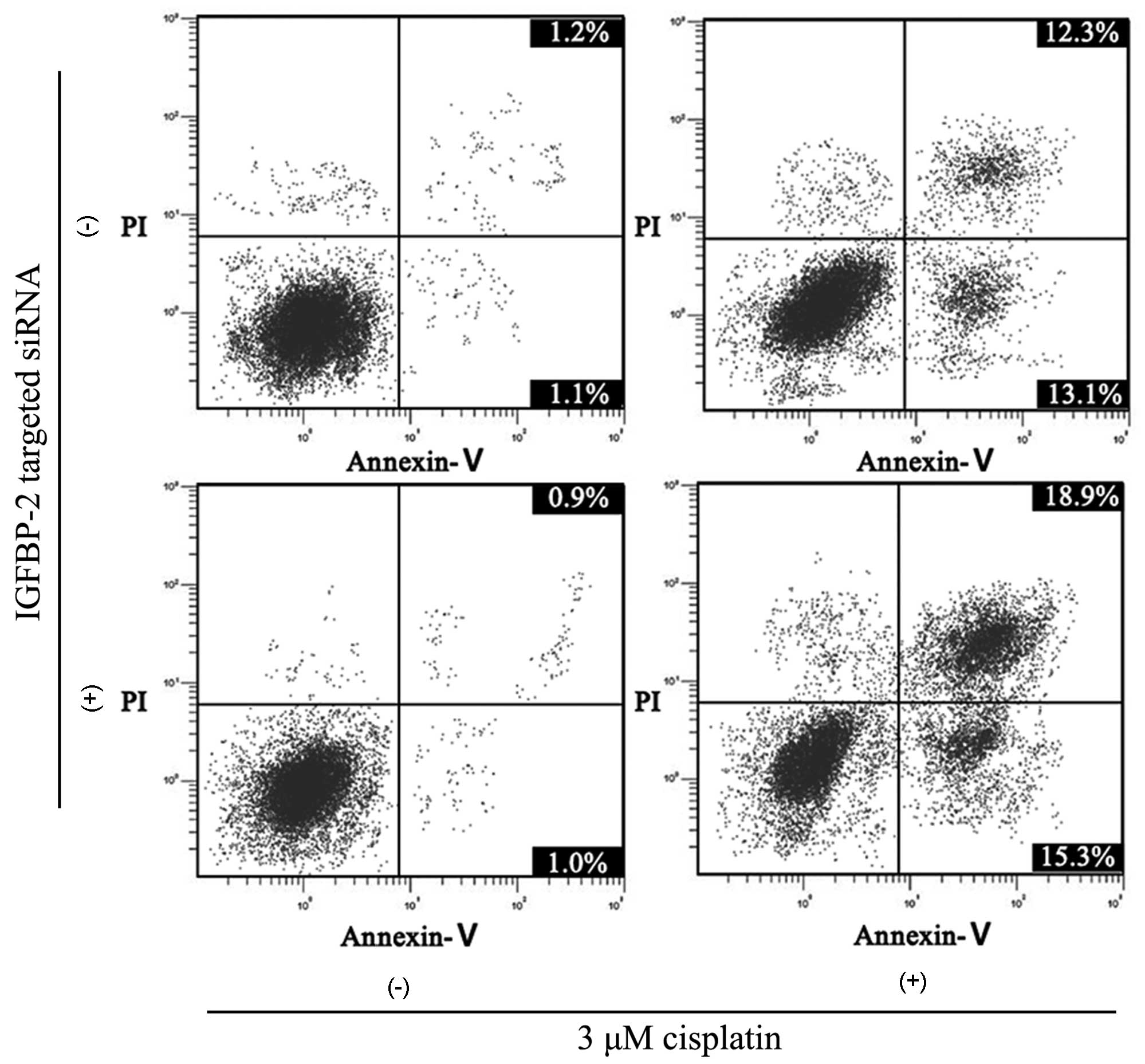Inhibition of IGFBP-2 improves the sensitivity of bladder cancer cells to cisplatin via upregulating the expression of maspin
- Authors:
- Published online on: June 17, 2015 https://doi.org/10.3892/ijmm.2015.2250
- Pages: 595-601
Abstract
Introduction
In China, the incidence of bladder cancer is the most prominent type of malignancy of the urinary system (1). With the exception of surgical treatment, chemotherapy is important for the therapy of bladder cancer. Cisplatin-based chemotherapy is widely used in bladder cancer treatment, with clear effects (2). However, a number of patients exhibit poor sensitivity to cisplatin, and this drug resistance is a problem that requires investigation. The low sensitivity to cisplatin and resulting drug resistance affect the therapeutic efficacy of bladder cancer treatment (3,4). Therefore, it is necessary to investigate the resistance mechanism of bladder cancer to cisplatin and attempt to improve the sensitivity of bladder cancer cells to it.
The specific binding of insulin-like growth factor binding protein (IGFBP) with insulin-like growth factor-1 (IGF-1), through regulating the activity of IGF-1, is important in the process of cell growth, development and proliferation (5,6). In the family of IGFBPs, IGFBP-2 has been investigated more extensively. Several studies have suggested that IGFBP-2 is associated with the occurrence and development of tumors, and a consensus of these reports is that IGFBP-2 overexpression is observed in tumor patients. For example, studies have suggested that the expression of IGFBP-2 is high in ovarian cancer, lung cancer and prostate cancer (7–9). These results suggest that excessive expression of IGFBP-2 sustains the growth of tumor cells and inhibits apoptosis. These effects of IGFBP-2 have been suggested as being not only IGF-1-dependent (10,11). It is not difficult to hypothesize that IGFBP-2 may be associated with the chemotherapy drug resistance of tumor cells, and changing the expression of IGFBP-2 expression may change the sensitivity of tumor cells to chemotherapeutic drugs. In terms of tumor drug resistance, previous investigation has revealed that increased expression of IGFBP-2 is associated with chemotherapy tolerance of prostate cancer induced by hyperglycemia (12). Trastuzumab-resistance in breast cancer is also associated with the overexpression of IGFBP-2, which overactivates ErbB2 (13). However, whether IGFBP-2 is associated with the drug resistance of bladder cancer cells to cisplatin, and how IGFBP-2 may be regulated to alter the sensitivity of bladder cancer cells to cisplatin remain to be fully elucidated.
Maspin can inhibit serine protease, and several studies have demonstrated that maspin can inhibit tumor growth by inducing apoptosis (14,15). In certain types of tumor, maspin is often expressed at low levels (16). Therefore, the present study hypothesized that maspin is associated with the sensitivity of bladder cancer cells to cisplatin. To confirm this, the present study examined the expression of IGFBP-2 in bladder cancer tissues, BIU87 cells and cisplatin-resistant BIU87 (BIU87-CisR) cells. Furthermore, small interfering (si)RNA technology was used to inhibit the expression of IGFBP-2 in bladder cancer BIU87-CisR cells, to determine changes of the sensitivity of BIU87-CisR cells to cisplatin and to examine changes in the expression of maspin following IGFBP-2 inhibition.
Materials and methods
Patients and preparation of tissue specimens
The present study recruited 32 patients with bladder cancer (18 male and 14 female, median age 65.9, range 51–76), who had undergone surgery and cisplatin-based combination chemotherapy between March 2012 and February 2013. Of these patients, 20 were sensitive to chemotherapy, while 12 were resistant to chemotherapy, however the information obtained regarding demographic data, including age, gender, stage of disease and treatment were not statistically different. Tumor tissue specimens were obtained during the surgical bladder cancer tissue resection and were stored in liquid nitrogen until further analysis. The present study was approved by the Ethics Committee and the informed consent was obtained from all patients.
Cell culture
The BIU87 cell line was purchased from the Type Culture Collection of the Chinese Academy of Sciences (Shanghai, China). The cisplatin-resistant subline, termed the BIU87-CisR cell line, was established as in our preliminary experiment, and its resistance to cisplatin was confirmed. BIU87-CisR cells were obtained from parental BIU87 cells through continuous exposure to increasing concentrations of cisplatin over 12 months, with the final concentration of cisplatin being 6 μM. In brief, BIU87 cells were planted in 6-well plate with a density of 100,000/well, and treated with 0.25, 0.5, 1, 2, 4 and 6 μM cisplatin for 2 months. The BIU87 cell line and BIU87-CisR cell line were maintained in RPMI-1640 medium (Thermo Fisher Scientific, Waltham, MA, USA) supplemented with 10% fetal bovine serum at 37°C in 5% CO2 conditions.
Transfection of IGFBP-2 siRNA
Downregulation of the expression of IGFBP-2 in BIU87-CisR cells was induced using siRNA. siRNA targeted to human IGFBP-2 was designed and synthesized (GenePharma, Shanghai, China) with the target sequence: 5′-UGG CGA UGA CCA CUC AGA A-3′ and transfected into the cells in 24-well plate (100,000 cells/well) using Lipofectamine® 2000 reagent (Invitrogen Life Technologies, Carlsbad, CA, USA). The concentration of siRNA was 100 nM and the BIU87-CisR cells were cultured for 48 h following transfection. The silencing effect was then assessed at the mRNA and protein levels.
RNA isolation and quantification of the mRNA expression levels of IGFBP-2 and maspin in the tissues and cell lines
Reverse transcription-quantitative polymerase chain reaction (RT-qPCR) was performed to quantify the mRNA expression levels of IGFBP-2. The total RNA of the tumor tissue specimens (n=32), BIU87 cells, BIU87-CisR cells and IGFBP-2-silenced BIU87-CisR cells were extracted using TRIzol reagent (Thermo Fisher Scientific). The purity and concentration of the total RNA were verified using spectrophotometry (NanoDrop 3300; Thermo Fisher Scientific). The qualified RNA was reverse-transcribed into cDNA using PrimeScript® RT reagent (Takara Biotechnology Co., Ltd., Dalian, China), according to manufacturer’s instructions, The cDNA was then amplified using a SYBR® Premix Ex Taq™ II kit (Takara Biotechnology Co., Ltd.) on a 7500 Real-Time PCR system (Applied Biosystems, Foster City, CA, USA). The cycling conditions were set (20 μl reaction volumes), according to the manufacturer’s instructions. The cells were incubated for 30 sec at 95°C and then amplified for 40 cycles; in each cycle reaction volume the cells were incubated at 95°C for 5 sec and 60°C for 30 sec. The primers (all designed by Takara Biotechnology Co., Ltd.) of the targeted genes and glyceraldehyde 3-phosphate dehydrogenase (GAPDH) were as follows: IGFBP-2, forward 5′-CAA GCA TGG CCT GTA CAA CCTC-3′ and reverse 5′-GGG TTC ACA CAC CAG CAC TC-3′; Maspin, forward 5′-AAC TGA AGA TGG TGG GGA TT-3′ and reverse 5′-TGG GAA GAA GAG CTT CCA AA-3′; and GAPDH, forward 5′-CGG AGT CAA CGG ATT TGG TCG TAT-3′ and reverse 5′-AGC CTT CTC CAT GGT GGT GAA GAC-3′. The fold changes in the target genes were calculated using the comparative cycle threshold (2−ΔΔCt) method (17), and the result was normalized by GAPDH.
Western blot analysis for the protein expression levels of IGFBP-2 and maspin
The proteins in the tissue samples and cells were extracted using the using radioimmunoprecipitation assay reagent combined with 1% protease inhibitor cocktail (Applygen Technologies, Inc., Beijing, China). The protein samples (30 μg) were separated by 12% sodium dodecyl sulfate-polyacrylamide gel electrophoreseis (SDS-PAGE; 100 V, 1.5 h; Applygen Technologies, Inc.) and then transferred onto polyvinylidene difluoride membranes (150 mA, 1 h; Applygen Technologies, Inc.). The membranes were blocked with 5% skim milk in phosphate-buffered saline (PBS) for 1 h and incubated at 4°C for 12 h with the primary antibodies mouse anti-human IGFBP-2 (Cat. no. sc-130070; 1:1,000), mouse anti-human β-actin (Cat. no. sc-130301; 1:5,000) or mouse anti-human maspin (Cat. no. sc-166260; 1:500). All primary antibodies were monoclonal and purchased from Santa Cruz Biotechnology Co., Ltd. (Shanghai, China). The membranes were washed with PBST buffer, followed by incubation with horseradish-peroxidase-conjugated secondary antibodies for 2 h at room temperature. The bands were detected using an ECL Detection Reagent kit (Applygen Technologies, Inc.) and analyzed using Image J 1.48 software (National Institutes of Health, Bethesda, MD, USA).
Cell inhibition analysis
The induction of cell inhibition by cisplatin was detected using a Cell Counting Kit-8 (CCK-8) kits (Boster Biological Engineering Co., Ltd., Wuhan, China). The BIU87 cells, BIU87-CisR cells and IGFBP-2-silenced BIU87-CisR cells were plated at a density of 1×104 cells per well in a 96-well plate and treated with 3 μM cisplatin for 0, 6, 12, 18 and 24 h at 37°C. Following cisplatin exposure, 10 μl CCK-8 cell counting reagent was added and incubated at 37°C for 4 h, the optical density of the culture solution in each plate was measured using a plate reader (ELX800; BioTec, Winooksi, VT, USA) at 450 nm.
Cell cycle and cell apoptosis analysis
The BIU87-CisR cells and IGFBP-2-silenced BIU87-CisR cells were treated with 3 μM cisplatin for 24 h, and cell cycle and cell apoptosis analysis were performed using a flow cytometer. For cell cycle analysis, the cells were collected and fixed with pre-cold 70% ethanol. After 12 h, 500 μl propidium iodide (Sigma-Aldrich, St. Louis, MO, USA) was added, and the cells were incubated for 30 min. Cell cycle analysis was performed using a BD FACSCalibur flow cytometer (Beckman Coulter, Miami, FL, USA) within 15 min. For cell apoptosis analysis, an Annexin V-FITC Assay kit was used, according to the manufacturer’s protocol.
Overexpression of maspin and its effect on sensitivity to cisplatin of BIU87-CisR cells
The pcDNA-maspin recombinant plasmids, constructed in our preliminary experiment, were transfected into the BIU87-CisR cells planted in 24-well plate (100,000 cells/well) using Lipofectamine® 2000 reagent in order to increase the expression of maspin. The proliferation inhibition of the maspin-overexpressing BIU87-CisR cells treated with 3 μM cisplatin for 24 h was analyzed using a CCK-8 kit, with the same methods as mentioned above.
Statistical analysis
All data are expressed as the mean ± standard deviation. All calculations were performed using SPSS 18.0 statistical software (SPSS, Chicago, IL, USA). A one-way analysis of variance, followed by a least significant difference test, were used to determine the statistical significance among four groups and between each group. P<0.05 was considered to indicate a statistically significant difference.
Results
Higher expression levels of IGFBP-2 are detected in tumor tissue from chemoresistant patients and in BIU87-CisR cells
The mRNA levels of IGFBP-2 were higher (1.70±0.08-fold) in the chemoresistant patients, compared with the chemosensitive patients (P<0.05; Fig. 1). Western blot analysis confirmed the protein expression of IGFBP-2 was also higher in the chemo-resistant patients (Fig. 2). In the BIU87-CisR cells, higher expression levels of IGFBP-2 were also observed, compared with the BIU87 cells (1.55±0.06-fold; P<0.05), at the mRNA and protein levels (Figs. 3 and 4).
Lower expression levels of maspin are detected in tumor tissues of chemoresistant patients and in BIU87-CisR cells
In contrast to the expression of IGFBP-2, the mRNA level of maspin was lower (0.67±0.08-fold) in the chemoresistant patients (Fig. 5), compared with the chemosensitive patients (P<0.05). Western blot analysis also confirmed the same observation in the protein levels of maspin (Fig. 6). In the BIU87-CisR cell line, lower expression levels of maspin were observed at the mrRNA and protein levels, compared with the BIU87 cells (0.61±0.04-fold; P<0.05). In addition, following IGFBP-2 inhibition, the mRNA and protein expression levels of maspin in the BIU87-CisR cells increased significantly (Figs. 7 and 8).
Knockdown of IGFBP-2 enhances the inhibitory effect of cisplatin on proliferation
Cisplatin (3 μM) treatment was observed to induce cell death in a time-dependent manner (Fig. 9). Following 24 h cisplatin exposure, the cell viability was significantly lower in the BIU87 cells (P<0.05), compared with the BIU87-CisR cells and IGFBP-2 silenced BIU87-CisR cells. The normal BIU87 cells were the most sensitive to cisplatin, and the BIU87-CisR cells exhibited significant resistance to cisplatin, compared with the normal BIU87 cells. However, the IGFBP-2-silenced BIU87-CisR cells were more sensitive to cisplatin, compared with the BIU87-CisR cells without siRNA treatment.
Knockdown of IGFBP-2 contributes to G2/M phase arrest of BIU87-CisR cells induced by cisplatin
Cisplatin was observed to arrest BIU87 cells at the G2/M phase (Fig. 10). In the BIU87-CisR group, the percentages of the cell population at the G0/G1 phase was 70.34±4.45% and at the G2/M phase was 8.5±0.9%. Following 3 μM cisplatin treatment, the proportion of cells at the G0/G1 phase deceased to 56.9±4.3%, Whereas the proportion of cells at the G2/M phase increased to 38.3±4.1%. In addition, IGFBP-2 silencing marginally suppressed the proportion of cells at the G0/G1 phase (35.5±6.5%) and elevated the percentage of cells at the G2/M phase (48.3±6.1%). The differences between each group were statistically significant (P<0.05).
Apoptosis of BIU87 cells caused by cisplatin increases following inhibition of IGFBP-2
Similar to the results of the cell cycle analysis, the silencing of IGFBP-2 enhanced the apoptosis-promoting effect of cisplatin. The apoptotic rate in the BIU87-CisR cells was 2.9±0.6% and, following 3 μM cisplatin treatment, the apoptotic rate increased to 22.6±2.4%. However, in the IGFBP-2-silenced BIU87-CisR cells, the apoptotic rate induced by cisplatin was 35.9±3.2% (Fig. 11). The differences between each group were statistically significant (P<0.05).
Overexpression of maspin may improve the sensitivity of BIU87-CisR cells to cisplatin (Fig. 12)
Following 3 μM cisplatin treatment for 24 h, the maspin-overexpressing BIU87-CisR cells exhibited a lower cell viability, compared with the normal BIU87-CisR cells (68.1±5.3, vs. 75.3±4.6%, respectively; P<0.05). This suggests that inhibition of IGFBP-2 may improve the sensitivity of bladder cancer cells to cisplatin via upregulating the expression of maspin.
Discussion
Carcinoma of the urinary bladder is a common and life-threatening malignant tumor of the urinary system. The preferred treatment option for this type of cancer is resection of the bladder and pelvic lymphadenectomy. However, for patients with advanced-stage disease, a high recurrence rate following surgery has been reported, and certain elderly patients with cardiac or pulmonic insufficiency cannot tolerate radical surgery (18). Therefore, chemotherapy has become an important aspect of bladder cancer treatment, particularly for patients with tumor metastasis or advanced-stage cancer (19). During the process of using cisplatin as a treatment approach, the response of patients to the drug is low and certain patients exhibit drug resistance, which leads to ineffective chemotherapy, increased recurrence rate, poor prognosis and increased economic burden (20). The present study was designed to reveal the molecular mechanism underlying the sensitivity of bladder cancer cells to cisplatin, and to provide novel methods to improve the sensitivity of bladder cancer cells to cisplatin.
In the present study, the expression of IGFBP-2 in patients with cisplatin-resistance was significantly higher at the mRNA and protein levels. Previous studies have demonstrated that IGFBP-2 overexpression reduces prostate cancer cell apoptosis induced by docetaxel and reduces the sensitivity of non-small cell lung cancer to dasatinib (12,21); it also increases chemotherapy resistance in patients with adult acute myeloid leukemia (22). Therefore, the present study hypothesized that IGFBP-2 overexpression may be associated with reduced sensitivity of bladder cancer cells to cisplatin. To investigate this, siRNA was used to downregulate the expression of IGFBP-2 in the BIU87-CisR cells. The results revealed that, following IGFBP-2 inhibition, the proliferation of cells exposed to cisplatin was further inhibited, more cells were in G2/M phase arrest, and the apoptotic rate also increased. These results indicated that inhibiting the expression of IGFBP-2 improved the sensitivity of the bladder cancer cells to cisplatin.
There are two mechanisms by which IGFBP-2 reduces cancer cell apoptosis and increases its proliferation. The first is the IGF-1-dependent pathway, which involves adjustment of the IGF-1 system through the binding of IGF-1 and IGFBP-2, which reduces the interaction of IGF-1 with its receptor and inhibits signal transmission (23). The other mechanism is the IGF-1-independent pathway. Lu et al (21) demonstrated that IGFBP-2 may activate the FAK pathway to inhibit the apoptosis of non-small cell lung cancer, and used dasatinib combined with FAK inhibitor to inhibit small-cell lung cancer with overexpressed IGFBP-2. In lung adenocarcinoma, the overexpression of IGFBP-2 inhibits the activity of IGF-1 signaling pathways and reduces the activity of caspase-3, which limits cancer cell apoptosis (24). By using the recombination of IGFBP-2 to process breast cancer cell Hs578T, Frommer et al (25) found that a series of factors associated with apoptosis resistance, including nuclear factor-κ and B-cell lymphoma-2 (Bcl-2) were increased. The present study demonstrated that, following the inhibition of IGFBP-2, the expression of maspin was significantly increased. Maspin has tumor suppressor functions as, in addition to inhibiting cancer cell metastasis, maintaining cell adhesion and inhibiting tumor angiogenesis (26), it can induce cancer cell apoptosis through Bcl-2 and B-cell-associated X protein (27). Therefore, IGFBP-2 may increase the expression of maspin and further increase the susceptibility of bladder cancer cells to cisplatin with the assistance of the tumor suppressor function of maspin. It is generally acknowledged that the expression of maspin is predominantly regulated by methylation/demethylation, and the methylation enhancement of its gene promoter may lead to reduced expression of maspin (28), however, the mechanism underlying the increased expression of maspin by IGFBP-2 remains to be elucidated. Further in-depth investigations are required to determine whether IGFBP-2 affects the promoter methylation of maspin. Based on the findings of the present study, inhibiting IGFBP-2 may improve the susceptibility of bladder cancer cells to cisplatin, the mechanism of which is associated with changes to the expression of maspin.
References
|
Xu W, Wang F, Ying L and Wang HH: Association between glutathione S-transferase M1 null variant and risk of bladder cancer in Chinese Han population. Tumour Biol. 35:773–777. 2014. View Article : Google Scholar | |
|
Costantini C and Millard F: Update on chemotherapy in the treatment of urothelial carcinoma. ScientificWorldJournal. 11:1981–1994. 2011. View Article : Google Scholar : PubMed/NCBI | |
|
Shirato A, Kikugawa T, Miura N, et al: Cisplatin resistance by induction of aldo-keto reductase family 1 member C2 in human bladder cancer cells. Oncol Lett. 7:674–678. 2014.PubMed/NCBI | |
|
Galluzzi L, Vitale I, Michels J, et al: Systems biology of cisplatin resistance: past, present and future. Cell Death Dis. 5:e12572014. View Article : Google Scholar : PubMed/NCBI | |
|
Hjortebjerg R and Frystyk J: Determination of IGFs and their binding proteins. Best Pract Res Clin Endocrinol Metab. 27:771–781. 2013. View Article : Google Scholar : PubMed/NCBI | |
|
Malaguarnera R and Belfiore A: The emerging role of insulin and insulin-like growth factor signaling in cancer stem cells. Front Endocrinol (Lausanne). 5:102014. | |
|
Lancaster JM, Sayer RA, Blanchette C, et al: High expression of insulin-like growth factor binding protein-2 messenger RNA in epithelial ovarian cancers produces elevated preoperative serum levels. Int J Gynecol Cancer. 16:1529–1535. 2006. View Article : Google Scholar : PubMed/NCBI | |
|
Zhang Y, Ying X, Han S, et al: Autoantibodies against insulin-like growth factorbinding protein-2 as a serological biomarker in the diagnosis of lung cancer. Int J Oncol. 42:93–100. 2013. | |
|
Uzoh CC, Holly JM, Biernacka KM, et al: Insulin-like growth factor-binding protein-2 promotes prostate cancer cell growth via IGF-dependent or -independent mechanisms and reduces the efficacy of docetaxel. Br J Cancer. 104:1587–1593. 2011. View Article : Google Scholar : PubMed/NCBI | |
|
Hoeflich A, Fettscher O, Preta G, et al: Increased activity of catalase in tumor cells overexpressing IGFBP-2. Horm Metab Res. 35:816–821. 2003. View Article : Google Scholar | |
|
Wheatcroft SB and Kearney MT: IGF-dependent and IGF-independent actions of IGF-binding protein-1 and -2: implications for metabolic homeostasis. Trends Endocrinol Metab. 20:153–162. 2009. View Article : Google Scholar : PubMed/NCBI | |
|
Biernacka KM, Uzoh CC, Zeng L, et al: Hyperglycaemia-induced chemoresistance of prostate cancer cells due to IGFBP2. Endocr Relat Cancer. 20:741–751. 2013. View Article : Google Scholar : PubMed/NCBI | |
|
Dokmanovic M, Shen Y, Bonacci TM, et al: Trastuzumab regulates IGFBP-2 and IGFBP-3 to mediate growth inhibition: implications for the development of predictive biomarkers for trastuzumab resistance. Mol Cancer Ther. 10:917–928. 2011. View Article : Google Scholar : PubMed/NCBI | |
|
Snoeren N, Emmink BL, Koerkamp MJ, et al: Maspin is a marker for early recurrence in primary stage III and IV colorectal cancer. Br J Cancer. 109:1636–1647. 2013. View Article : Google Scholar : PubMed/NCBI | |
|
Hall DC, Johnson-Pais TL, Grubbs B, Bernal R, Leach RJ and Padalecki SS: Maspin reduces prostate cancer metastasis to bone. Urol Oncol. 26:652–658. 2008. View Article : Google Scholar : PubMed/NCBI | |
|
Machowska M, Wachowicz K, Sopel M and Rzepecki R: Nuclear location of tumor suppressor protein maspin inhibits proliferation of breast cancer cells without affecting proliferation of normal epithelial cells. BMC Cancer. 14:1422014. View Article : Google Scholar : PubMed/NCBI | |
|
Livak KJ and Schmittgen TD: Analysis of relative gene expression data using real-time quantitative PCR and the 2(-Delta Delta C(T)) Method. Methods. 25:402–408. 2001. View Article : Google Scholar | |
|
Shariat SF, Milowsky M and Droller MJ: Bladder cancer in the elderly. Urol Oncol. 27:653–667. 2009. View Article : Google Scholar : PubMed/NCBI | |
|
Drayton RM, Dudziec E, Peter S, et al: Reduced expression of miRNA-27a modulates cisplatin resistance in bladder cancer by targeting the cystine/glutamate exchanger SLC7A11. Clin Cancer Res. 20:1990–2000. 2014. View Article : Google Scholar : PubMed/NCBI | |
|
Svatek RS, Hollenbeck BK, Holmang S, et al: The economics of bladder cancer: costs and considerations of caring for this disease. Eur Urol. 66:253–262. 2014. View Article : Google Scholar : PubMed/NCBI | |
|
Lu H, Wang L, Gao W, et al: IGFBP2/FAK pathway is causally associated with dasatinib resistance in non-small cell lung cancer cells. Mol Cancer Ther. 12:2864–2873. 2013. View Article : Google Scholar : PubMed/NCBI | |
|
Kühnl A, Kaiser M, Neumann M, et al: High expression of IGFBP2 is associated with chemoresistance in adult acute myeloid leukemia. Leuk Res. 35:1585–1590. 2011. View Article : Google Scholar : PubMed/NCBI | |
|
Fukushima T and Kataoka H: Roles of insulin-like growth factor binding protein-2 (IGFBP-2) in glioblastoma. Anticancer Res. 27:3685–3692. 2007.PubMed/NCBI | |
|
Migita T, Narita T, Asaka R, et al: Role of insulin-like growth factor binding protein 2 in lung adenocarcinoma: IGF-independent antiapoptotic effect via caspase-3. Am J Pathol. 176:1756–1766. 2010. View Article : Google Scholar : PubMed/NCBI | |
|
Frommer KW, Reichenmiller K, Schutt BS, et al: IGF-independent effects of IGFBP-2 on the human breast cancer cell line Hs578T. J Mol Endocrinol. 37:13–23. 2006. View Article : Google Scholar : PubMed/NCBI | |
|
Taskiran C, Erdem O, Onan A, et al: Maspin expression in endometrial hyperplasia and carcinoma, and its relation with angiogenesis. Eur J Gynaecol Oncol. 35:134–139. 2014.PubMed/NCBI | |
|
Romani AA, Soliani P, Desenzani S, et al: The associated expression of maspin and Bax proteins as a potential prognostic factor in intrahepatic cholangiocarcinoma. BMC Cancer. 6:2552006. View Article : Google Scholar : PubMed/NCBI | |
|
Rivenbark AG, Stolzenburg S, Beltran AS, et al: Epigenetic reprogramming of cancer cells via targeted DNA methylation. Epigenetics. 7:350–360. 2012. View Article : Google Scholar : PubMed/NCBI |



